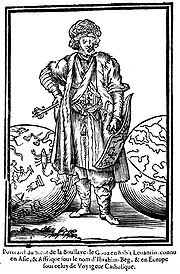Francois de La Boullaye Le Gouz
- Francois de La Boullaye Le Gouz
-

François de La Boullaye Le Gouz
François de La Boullaye Le Gouz (* 1610 in Baugé, Anjou; † 1668 oder 1669 in Isfahan) war ein französischer Aristokrat und Weltreisender.
François de La Boullaye Le Gouz verfasste und veröffentlichte die französischsprachige Reisebeschreibung Les voyages et observations du sieur de La Boullaye Le Gouz, in der er seine Reisen in Indien, Persien, Griechenland, Ägypten, dem Nahen Osten und anderen Weltgegenden - darunter Dänemark, Deutschland, die Niederlande, England, Irland und Italien - darstellte. Les voyages et observations gilt als eines der frühesten Beispiele für Reiseliteratur, die praktisch anwendbare Informationen für tatsächliche Reisende vermittelt.
Literatur
- Les voyages et observations du sieur de La Boullaye Le Gouz. Paris, 1657
Wikimedia Foundation.
Schlagen Sie auch in anderen Wörterbüchern nach:
François de La Boullaye Le Gouz — (* 1610 in Baugé, Anjou; † 1668 oder 1669 in Isfahan) war ein französischer Aristokrat und Weltreisender. François de La Boullaye Le Gouz verfasste und veröffentlichte die französischsprachige Reisebeschreibung … Deutsch Wikipedia
François de La Boullaye-Le Gouz — (1623 ndash; 1668/1669?), was a French aristocrat and extensive traveller.He published a French language travelogue, enriched with firsthand accounts of India, Persia, Greece, Egypt, the Middle East and many other places, including Denmark,… … Wikipedia
Gouz — François de La Boullaye Le Gouz François de La Boullaye Le Gouz (* 1610 in Baugé, Anjou; † 1668 oder 1669 in Isfahan) war ein französischer Aristokrat und Weltreisender. François de La Boullaye Le Gouz verfasste und veröffentlichte die… … Deutsch Wikipedia
Liste der Biografien/Gou — Biografien: A B C D E F G H I J K L M N O P Q … Deutsch Wikipedia
Travel literature — Travel writing and its most common sub genres First edition of … Wikipedia
Great Sphinx of Giza — The Great Sphinx of Giza ( ar. أبو الهول The Father of Fear ) is a half human, half lion Sphinx statue in Egypt, on the Giza Plateau at the west bank of the Nile River, near modern day Cairo. The largest monolith statue in the world, it stands 73 … Wikipedia
Cambric — Statue in Cambrai of Baptiste Chambray, the improbable inventor of the eponymous fabrics, batiste and chambray … Wikipedia
LIVRE — C’est vers le milieu du XVe siècle que la technique occidentale d’impression des textes au moyen de caractères mobiles fut mise au point, très vraisemblablement dans la région de Mayence. À partir de 1460, le nouvel art se répand très rapidement… … Encyclopédie Universelle
nabab — [ nabab ] n. m. • 1653; navabo 1614, du port.; mot hindoustani, ar. nuwwâb, plur. de naïb « lieutenant » 1 ♦ Hist. Titre donné dans l Inde musulmane aux grands officiers des sultans, aux gouverneurs de provinces. 2 ♦ (XVIIIe) Vx Européen qui… … Encyclopédie Universelle
PAMPHLET — PAMPHLE Au sens strict, le mot «pamphlet» désigne une brochure brève et incisive, une œuvre d’actualité, de combat et de passion attaquant le plus souvent violemment un personnage connu, un parti ou une institution. Bien que la brièveté (cent… … Encyclopédie Universelle

